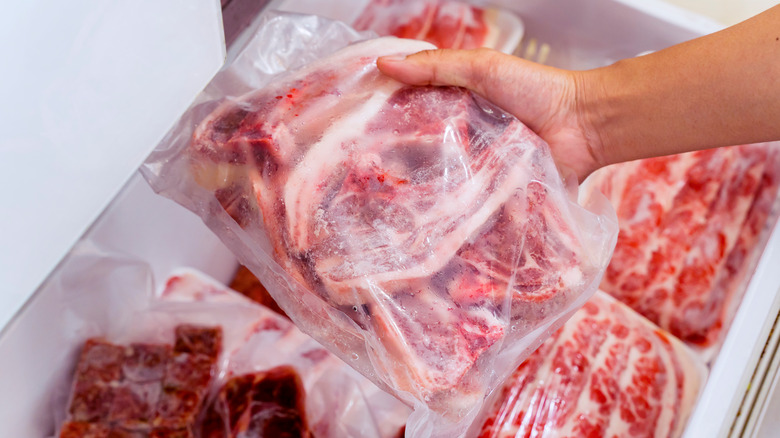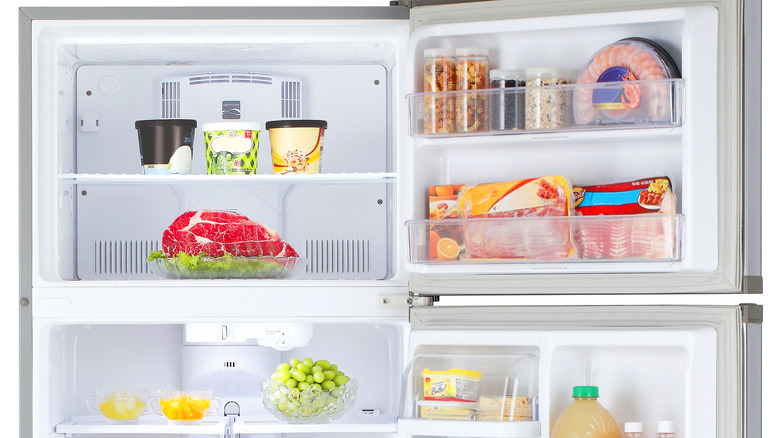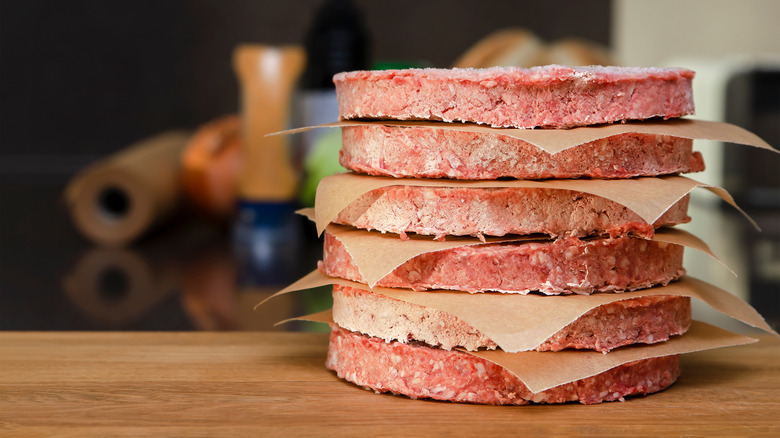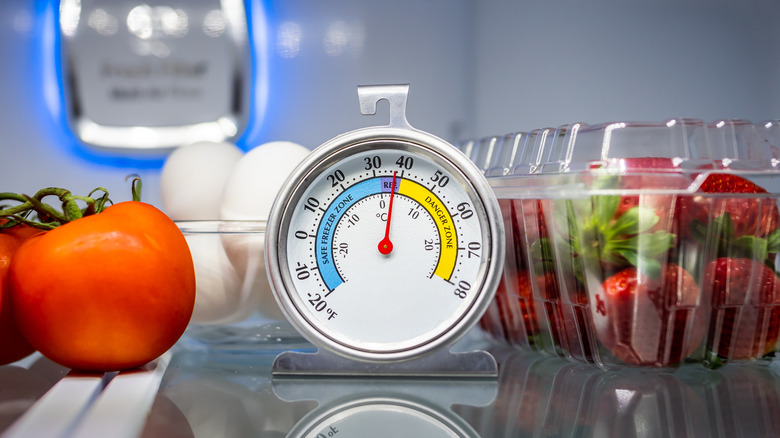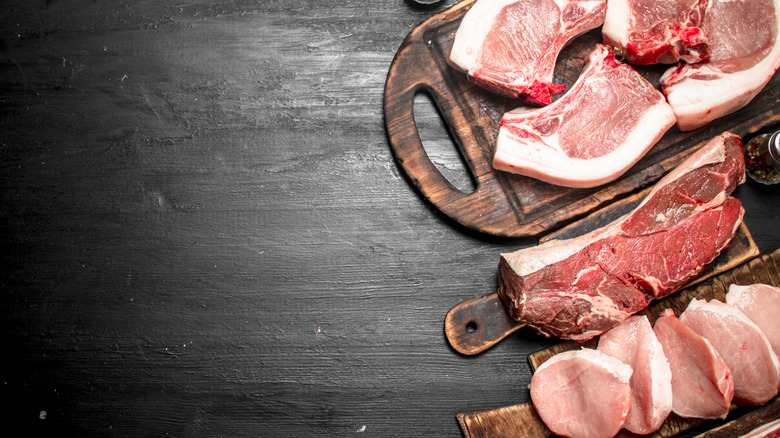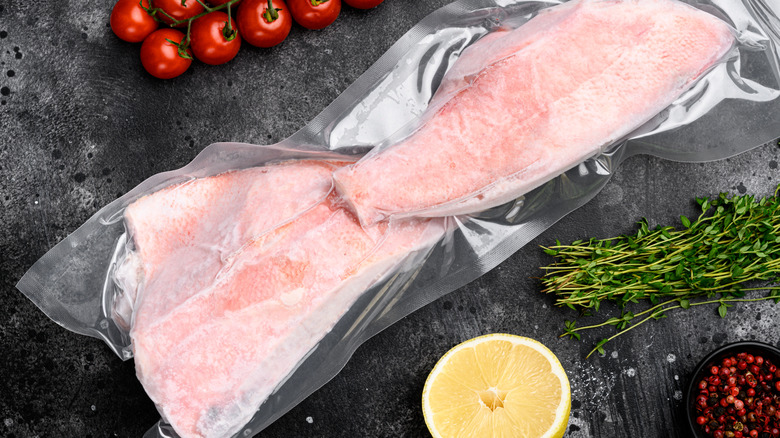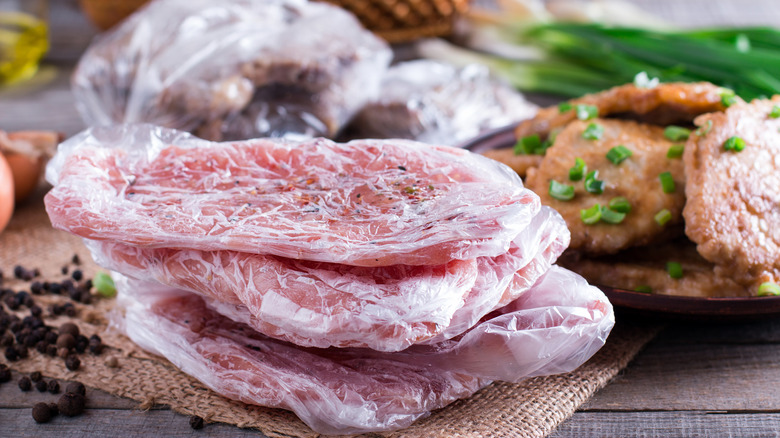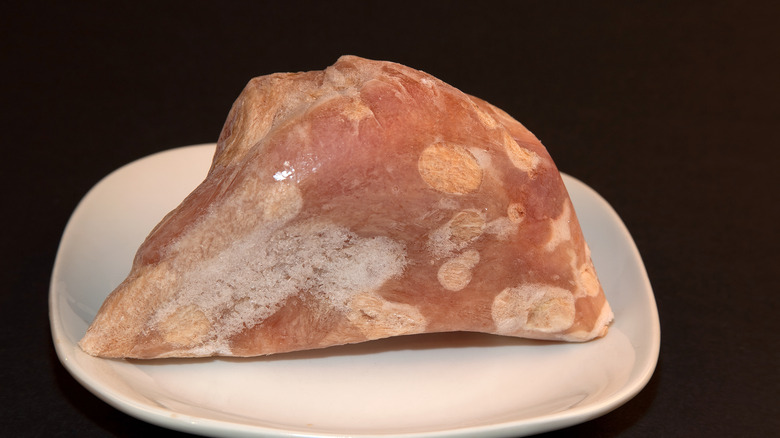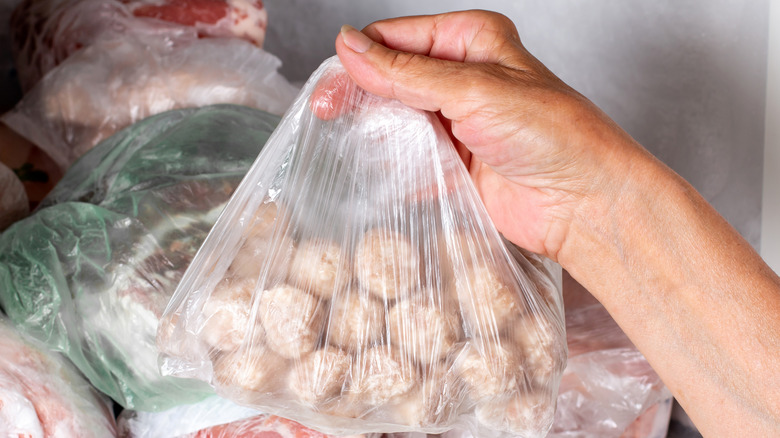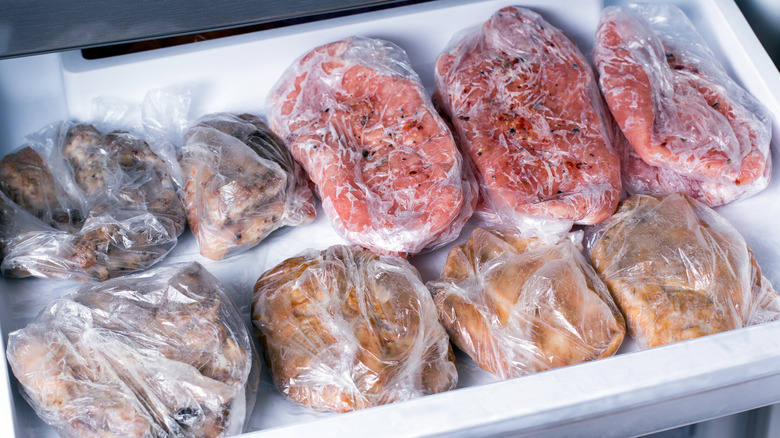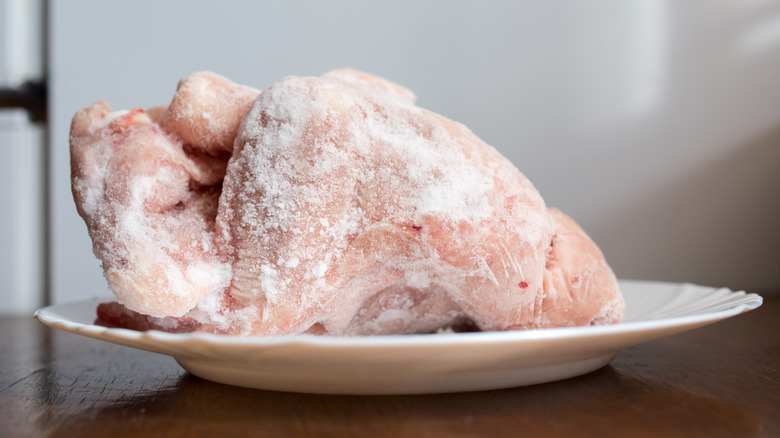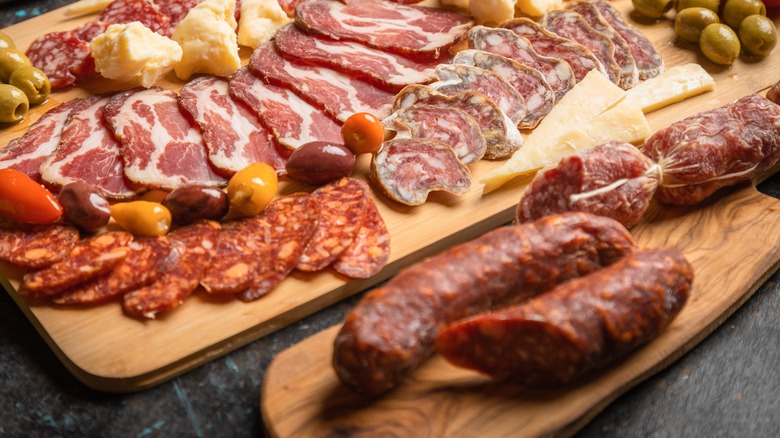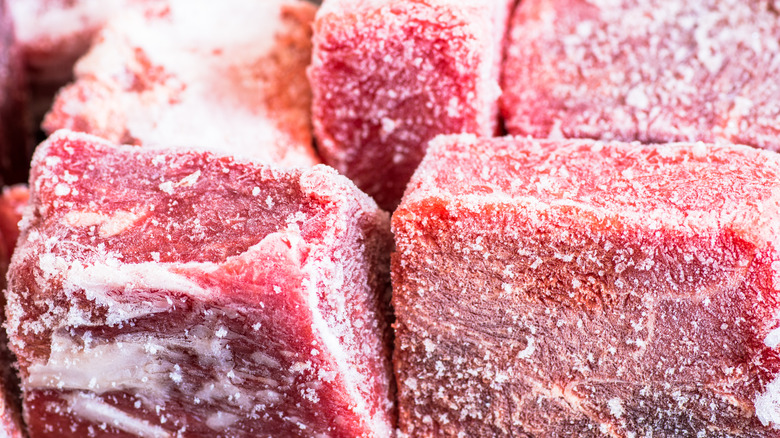You've Been Storing Meats Wrong Your Entire Life
Of all the foods that go in our fridge or freezer, few are as tricky to handle as meat. Raw meat carries a particular risk of harboring bacteria and causing foodborne illness. While food hygiene and sanitation are better than they've ever been, there's still the chance something can go wrong. And once meat turns bad, there's no bringing it back.
The spoilable nature of meat, and people's tentativeness around eating risky cuts of chicken and pork, may arguably contribute to overall food wastage. And the amount of meat that's thrown away each year is pretty shocking. Roughly a quarter of all meat produced for human consumption is wasted, according to the Food and Agriculture Organization of the United Nations.
So, how can we prevent such large-scale waste? It could start in our very own kitchens. Meat can quickly go bad or become inedible due to the way we're storing it at home. And, with a few simple changes and tips, you can become a meat-storing pro and ensure that you're never throwing out animal products again. Let's take a look at some mistakes when storing meats, and how to fix them.
In the fridge, position is everything
If you're not going to cook your meat immediately, it's vital to keep it refrigerated. But crucially, where you place meat in the fridge can have a big effect on its ability to keep. While most fridges are efficient at keeping foods chilled, they can vary in interior temperature, with some parts being warmer than others. The bottom shelf in your refrigerator tends to be the coolest, with things getting warmer the higher up you go. Putting meat on the top shelf, therefore, could mean that it's kept at a higher temperature and thus more susceptible to spoilage.
It's for this same reason that you shouldn't store meat in the refrigerator door. Like the top part of the refrigerator, your fridge door tends to be warmer. It's also more frequently exposed to air and temperature changes, due to it opening and closing constantly.
But there's another reason why you shouldn't keep your meat at the top of the fridge: its juices. Meat kept higher up is more likely to drip blood or juices down onto the food below. Not only can this be a nightmare to clean up, but it also makes the below food more prone to contact with bacteria, increasing the risk of foodborne illness.
Don't keep your meat in the fridge for too long
So, you've got a big meal planned tonight with your friends, and you've bought the beef. And then suddenly, everyone cancels. You rearrange for next week, no big deal. But what about that meat you've just acquired? Will it still be good to eat?
Unfortunately, things can start to go off faster than you might think. How long your meat will keep will depend on the cut and type you have, but generally, things start to go bad within three to four days. For many types of meat, things can spoil even faster, and it's generally best to try and consume it within a day or two. If you think you'll need a little more time, it's best to put meat straight into the freezer, to thaw when you're ready.
And if you're wondering how long leftover cooked meat is still okay for, it's not much longer. In fact, most cooked meats will last as long as raw meat does, with a three- to four-day window for eating it. The quicker you get your cooked meat into the fridge once fully cool, the more likely it is to last. Any cooked meat that's left out for a significant portion of time, longer than a few hours, may be riskier to eat.
Wrap it up properly
Freezers are incredible things, y'all. Gone are the days when the food you bought had to be eaten there and then. Nowadays, foods can last for weeks, even months, safely tucked away in your freezer. And that includes meats, which can chill (pun totally intended) in your deep freeze for months at a time before they're ready to be consumed.
But, to keep your meat good to eat, you have to prep it carefully. And that's why you should store meat in freezer paper. Freezer paper is specifically designed to keep moisture out of products, which can contribute to spoilage and freezer burn. With a plastic inside coating, this paper may potentially keep your meat fresher than its airy supermarket packaging.
Additionally, freezer paper is incredibly durable. This means that, unlike some other materials used to freeze meat, it won't rip or deteriorate in the freezer, exposing the food to the cold air. For the best results, try double-wrapping your meat in freezer paper, to further increase its protection.
The right temperature is essential
It's probably no great surprise that the colder a fridge or freezer is, the more energy it will use. But if storing meat regularly, it might be worth the few extra pennies to keep it consumable. To make your food last longer, things should be as chilly as possible. Ideally, your fridge should be set to a maximum of 40 degrees Fahrenheit. Going lower than that is certainly an option, too, and could assist with preserving the meat longer.
Just be sure you're not going overboard. The fridge is meant to keep things cool, after all, not frozen solid — that's what your freezer's for. And you should be setting your deep freeze at a maximum temperature of 0 degrees, so things stay, well, frozen.
Bear in mind that, when it comes to your fridge and freezer, one of the big mistakes people can make is overfilling them. This can affect the machine's ability to keep things at a proper temperature. If you've got any doubts or concerns about your fridge or freezer's internal temperature, it's best to buy an external thermometer to check it properly. This will give you an accurate read of its heat, especially for older machines, which may not have sophisticated temperature controls.
Different meats have different spoilage times
Not all meat is created equal. And it stands to reason that, along with having different sources, appearances, and tastes, different meats will also have different storage rules. The main variation when it comes to different meats is the time that they'll stay fresh. Interestingly, whole cuts of dark meat, like beef, pork, and lamb, generally last longer in the fridge. Technical information specialist for the USDA Meredith Carothers tells Mashed they can make it four to five days. Poultry, on the other hand, deteriorates rapidly and will only stay fresh in the fridge for a day or two.
Meat's freshness can also vary depending on the size of the cut. When cuts of meat are smaller, they tend to go off faster, whereas larger joints or full birds may last for a longer time. Crucially, too, ground meat is susceptible to rapid spoilage, tending to go off within a day or two. Ground beef expires so quickly because the grinding process creates a far larger surface area for bacteria to play upon.
Generally, you should keep different meats separate from one another to avoid cross-contamination. Ensure that you're fully sanitizing any surfaces that raw meat comes into contact with, and washing your hands before and after food preparation.
Make sure you prep fish correctly
Despite being different foodstuffs, fish and meat can often be treated similarly. But it's important to remember that fish is its own beast and should be handled with care. This is not only true when you're preparing fish for consumption but when you're preparing it for storage.
The main thing you need to know is how to prepare fish before freezing it. Fish can sometimes be pretty moist on its surface when buying it. And if you're freezing it without taking this moisture off, it can quickly deteriorate, losing its taste, texture, and overall appeal. Try to draw as much moisture out of your fish as possible before freezing it. This can be easily done with the help of a few paper towels, wrapped around the fish.
Ideally, vacuum-packing fish is the way to go when freezing it, as the lack of air will allow it to last longer. Naturally, though, not everyone has a vacuum packing machine lurking in their kitchen. And if you don't, the next best thing is wrapping it tightly in a resealable plastic bag, squeezing out as much air as possible.
Don't throw away your labels
When you're preparing meat for storage, especially for freezing, it's tempting to get rid of all the excess packaging. After all, the more space the better, and your freezer doesn't need all of that bulky plastic. But the one part of the packaging you should keep is the label.
It's vital to save the label when freezing meat as when you stash red meat products in the freezer, they have a habit of starting to look the same. Add to this the fact that you may be using materials that aren't see-through to store it, and you may not be sure whether what you're defrosting is pork, beef, or lamb. Keeping the label, therefore, allows you to know what meat you're dealing with.
But there's a little more to it than that. Importantly, keeping the label from your meat allows you to see roughly when you bought it, and its use-by date. You can then work forward to the current date and judge whether it'll still be good to eat. Generally, the meat will last a good few months in the freezer and may last even longer than that. It's generally advisable to use meat sooner rather than later, though, as it can decline in quality as it languishes in the freezer.
Portion it up
Buying a big block of ground beef or a huge tray of chicken thighs can be a cost-effective move. But what happens when the day comes that you need to use only some of it, and you pull it out of the freezer? Suddenly, that once-malleable meat has become a frozen mass, and you either need to defrost it all or crudely hack away at it, ruining your meal.
There's an easy fix to this problem, however: portioning it up. Dividing your meat into individual serving sizes before freezing them gets rid of the need to use it all in one go. This is a particularly good trick for freezing chicken, which has an annoying habit of becoming a completely solid block once in the freezer. Simply take each portion of chicken you'll want and put them in their own freezer bags, squeezing the air out and freezing them.
You can also place chicken pieces in one big bag by freezing them separately beforehand, although this does take some additional work. Arguably, the best of both worlds is to wrap them in individual freezer bags and then place them in a bigger bag together. That way, you'll keep them separate while also having them all in one place, with no rogue chicken pieces rattling around in your freezer drawer.
How to avoid freezer burn
Freezer burn is the enemy of all foods. Too many times, you've tucked a choice piece of meat away in the freezer, ready for that special meal in a few weeks. And then, once pulling it out, you've found that it looks patchy, has a weird texture, and certainly doesn't taste good. What gives?
The scientific reason freezer burn happens is all down to the drawing of moisture out of food. When the outside of your food is exposed to freezing-cold air, it starts to dehydrate. This can be exacerbated if your food has a layer of moisture on its outside, as the ice crystals that form then dissipate, taking water with them.
Avoiding freezer burn can be an eternal struggle, and when you're buying expensive meat, you've got to put the work in. But, luckily, there's a simple principle you need to follow: The less air, the better. When you store your meat, try to eliminate any excess air around it. Wrapping meat in tightly packed plastic is usually the best approach here. While this may mean that you need to repackage it, instead of simply freezing it in the tray it comes in, it's worth it.
Remember, you can freeze cooked meat too
Look, we know it sounds pretty dramatic, but leftovers make our lives so much better. Cooking up a showstopping meal and then knowing that you get to eat it again the next day? That's heaven. And what makes things even better is that if you're not ready to eat your leftover meat yet, you can throw it in the freezer.
Naturally, though, you'll need to know how to freeze it properly. The primary thing to keep in mind is that cooked meat should be frozen as soon as possible. Doing this will decrease its likelihood to develop bacteria on its surface and will keep it fresh in your freezer.
This doesn't mean, however, that you should pour it from the hot pan straight into your Tupperware and into the drawer. Not only will throwing hot food in the freezer melt the other food you have in there, but moisture from the steam can linger on your meat. This moisture can then turn into ice crystals, which then dissipate, dehydrating your food and causing freezer burn. As such, ensure that you're waiting until your food's fully cool before freezing it.
You can't keep meat in the freezer indefinitely
Ice has an incredible way of preserving things for way longer than we think possible. But, if you think that your meat can be pulled from the freezer drawer after years and cooked up like it was bought yesterday, you're mistaken. Meat can last for a much longer time in the freezer than in the fridge, but it's still perishable at subfreezing temperatures. Although bacteria growth will be inhibited, your meat will still be susceptible to freezer burn and dehydration, and over time, it'll lose its appeal.
If you properly freeze your meats, of course, they will last longer than if you freeze them in shoddy packaging. But it's still important to know how long you have for each type of meat. Some meats, like wild-caught game, whole poultry, and larger cuts of red meat may last for up to a year. Smaller chicken pieces may have slightly less time, with raw cuts having a maximum of nine months before they decline beyond retrieval. Thanks to its increased surface area encouraging faster freezer burn, raw ground meat will only last four months at most in your freezer. The meats you should seek to use quickly, though, are sausage, bacon, and ham. These more processed items should stay in your freezer for no more than two months before being used or thrown out.
Once defrosted, the same rules apply
Although freezing food preserves it for way longer than in its fresh state, that preservation doesn't last once it's defrosted. Meat has a short time in which it can be cooked, and after defrosting your food, that time span remains the same. Defrosted raw turkey, fish, and chicken should all be cooked within one to two days. While you have slightly longer with red meat like steaks and chops, they should still be used, ideally, within 72 hours.
Bear in mind, too, that how you defrost your meat is paramount to its eventual safety. Thawing your meat by placing it at room temperature increases its likelihood of developing harmful bacteria and spoiling your dinner and your stomach. That's why you should always defrost your meat in the fridge. While it does take significantly longer, defrosting in the fridge controls its thawing rate and therefore the amount that bacteria can grow. You should aim to get your meat in the fridge around 24 hours before you plan to use it. Remember that the larger the cut of meat, the longer it will take to defrost.
Cured meats shouldn't stay at room temperature
Although meat is pretty perishable, cured meat can be the exception. Cured meats harness the power of old-school preserving methods, adding salt and other ingredients to pull out moisture and limit bacterial growth. However, while salt-cured meats don't always have an explicit expiration date, they're still subject to deterioration. And once you open them, that can happen fast.
It's for this reason that you should never store cured meats in your pantry. Once the meat is exposed to oxygen, things can start to go south. And while spoilage may take a little longer, oxygen-exposed cured meat tends to dry out quickly, leaving you with a brittle, unappetizing disaster zone.
Therefore, once you've opened cured meats, get them in the fridge. It's best to limit further oxygen exposure by wrapping them up as tightly as possible, squeezing out any excess air. Storing cured meats in the fridge can give them a few extra weeks for consumption. You should check on it regularly, though. While thicker-cut meats can hold up well, more delicate meat slices may still dry out fast in the fridge.
Remember, you can refreeze meat
What do you do when you pull your meat out of the freezer, only to find that you don't need it after all? Do you just cook it up and hope that you can find a time to use it in a meal? Or simply throw it out?
Luckily, you don't have to do either. Once you've defrosted your meat, it's entirely possible to put it back into the freezer, provided that you haven't left it too long. You can then pull it back out of the freezer at a later time and cook it up then.
What you shouldn't expect, though, is that your meat will be the same quality the next time you defrost it. Refreezing meat can alter its moisture balance, potentially drying it out and making it less appealing to eat (per Healthline). The meat's structure can also be changed on a molecular level, leaving you with an overall worse-tasting end product. Meat can also discolor when frozen and defrosted repeatedly, and while this isn't a safety issue, it's not exactly pleasant to look at. So, while you can refreeze your meat, you may not want to.
